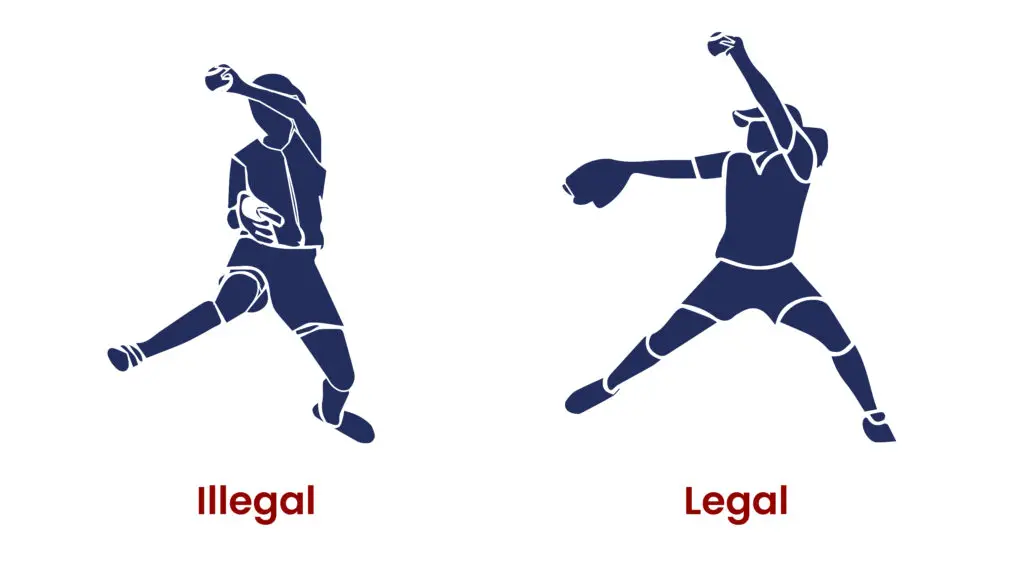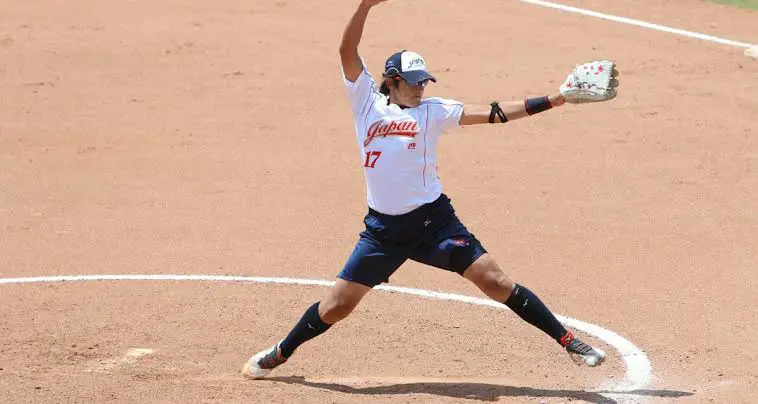The pitcher arguably has the most important role in softball. Since the mechanics of throwing in softball are so dissimilar to baseball, players and officials often struggle to agree on what is and is not allowed.

Things get even more convoluted when you include that Little League has a few rules that differ from those of high school and other young softball clubs.
No one wants to see one of their players have a nervous breakdown because the pitching techniques or illegal pitch rules they’ve been honing for months are against them.
Toe hopping, re-planting, stepping outside the pitching lane, a pitcher’s rear toe losing contact with the rubber, and the younger pitcher’s failure to present hands apart when stepping onto the rubber are the five most common illegal pitches in softball.
What are illegal pitches in softball?

Crow Hopping
Possibly the most common illegal pitch that frequently occurs in softball. When a pitcher lifts both feet off the ground simultaneously, they are said to be crow hopping.
A crow hop is synonymous with the actions of leaping or jumping. To prevent yourself from crow hopping, shift your weight onto your back foot, and it must remain in contact with the ground throughout the drag and finish phases of the race.
Re-Planting
When it comes to illegal pitching positions, the pitcher re-plant is still generating some news, even though it is not as widespread as the crow hop.
This illegal pitch occurs when the pitcher starts their drag, stops in the middle of their pitch, and then starts again. Because it is more difficult for umpires to spot than crow hopping, the re-plant isn’t called out nearly as the other illegal pitch is called.
Not sure if you re-plant? Check your drag pitching motion. If you observe that your drag starts, stops, and then continues, you are making an illegal pitch in softball. You are re-planting.
With a hop, leap, or jump, the pivot foot rises off the pitcher’s plate while the other foot remains in the air. A pitching plate violation occurs when the pitcher’s pivot foot leaves the plate and rests before it rather than dragging away.
It violates your pivot foot leaves the ground before your other foot does throughout any delivery stage. It is considered a leap, no matter how small, whenever both feet leave the ground simultaneously. It’s forbidden to have any clearance under the pivot foot higher than the ground.
Stepping outside the pitching lane
This silly illegal pitch in softball is even more ridiculous because very few pitchers are aware of this illegal pitch call. There is an imaginary pitching lane; you must stay within it while throwing your pitch.
This rule should not even be in place because it is impossible to enforce properly unless the pitching lane is marked with chalk before every game as a reference.
The width of the lane corresponds to the height of the pitching mound. An illegal pitch may be called against a pitcher if the umpire behind the plate sees that the pitcher has stepped too far outside the pitching lane.
This occurs once in a blue moon because most umpires behind the plate are preoccupied with the pitch coming in and won’t pay attention to the lane rule, especially if there isn’t a lane drawn anyways.
Back toe losing contact with the rubber
The rule book for throwing specifies that the pitcher’s feet must remain in touch with the rubber until she begins her forward motion.
When a pitcher loads into their legs, their rear toe may inadvertently move backward, causing them to lose contact with the rubber. If they observe this, the first base umpire may report the pitcher for throwing an unlawful pitch.
If you keep both feet in contact with the ground until you move forward during your pitch, you will entirely avoid this illegal pitch regulation.
Failure to present hands apart
This one is a staple for pitchers at the lower levels of softball games. Fortunately, most lower-level umpires will only issue a warning to pitchers rather than making an illegal pitch call.
When a pitcher steps onto the pitching rubber, both hands must be separated by the game’s rules. It does not make a difference whether the ball is held in the pitcher’s hand or lying in the glove; nonetheless, the pitcher’s hands are required to be apart until he receives the sign from the catcher.
After that, the pitcher can bring her hands together and begin her pre-motion, followed by the delivery of the pitch. If you continue to do this and make it a habit, eventually, it will become usual.
The pitcher can only take one step toward the batter before releasing the ball. This step must be taken with the foot, not in the pivot position. A crow hop is an illegal step that consists of a first step with the pivot foot, which involves breaking contact with the pitcher’s plate, followed by an extra step with the foot that is not the pivot foot. Due to the fact that the pitcher is now closer to the plate as a result of the extra step, the pitcher is, in effect, pitching from closer than the distance that is legally allowed.
Any action that does not adhere to the abovementioned procedures constitutes a breach of the rules and an illegal pitch.
The vast majority of travel tournaments for girls in age groups 12, 14, 16, and 18U are sanctioned by USA Softball. USA Softball rules are used for all collegiate and women’s 19 and older competitions at state, regional, national, and Olympic levels.
One foot on the pitcher’s plate and one step backward is not permitted in any sanctioned tournament, except for games played according to high school regulations.
Any pitcher who conforms to the norms set forth by USA Softball also satisfies the criteria established by the Federation (but not visa versa.)
